Exercise is important for maintaining your general health, but excessive exercise can cause injury to the Achilles tendon, the line of tissue that connects the muscles of the calf to the heel bone. Walking, running, and jumping are the foundational movements in most sports, but all of them place strain on the Achilles tendon. In older people, or among those who exercise only occasionally, the tendon may be more prone to injury, especially if you suddenly increase the intensity of your exercise. Inflammation of the Achilles tendon is among the most common injuries in sports, second only to patellar tendonitis, commonly known as jumper’s knee.
Achilles tendonitis is initially felt as a slight ache in the back of the heel or lower leg after physical activity. More severe tendon pain may result from long periods of running or climbing. The pain tends to be worse in the morning when the joints are stiff, and gentle exercise usually provides some relief. To determine whether the tendon is inflamed, lay on your stomach and pinch the tendon between your fingers. If the tendon feels especially tight or painful, or you feel a sense of heat, you are probably suffering from inflammation. Using acupressure massage at home can provide significant relief, but in more severe cases you’ll want to visit a qualified professional who can administer acupuncture for Achilles tendonitis.
What Are The Treatments For Achilles Tendonitis?
As with other tendon conditions, the best medicine for Achilles tendonitis is preventative. By strengthening and stretching the inner muscles and building up to intense exercise more gradually, you can avoid many repetitive strain injuries. You can use acupressure for Achilles tendonitis to improve the flow of blood to the legs, warm up the body before exercise, and relieve tension and strain in the muscles after a workout.
Immediately after an injury, you should follow the RICE method: Rest, Ice, Compression, and Elevation. Use ice to reduce pain and inflammation, wrap the injured area to prevent swelling, and elevate the affected limb above the heart. You may want to use tape to provide support to the heel, preventing it from bending too much. After two or three days, however, inflammation subsides, and the muscles become tight and stiff. At this stage, you can use the acupuncture points for Achilles tendonitis to ease the tension in the muscles and increase blood flow to the affected area.
Is Acupuncture Good For Tendonitis?
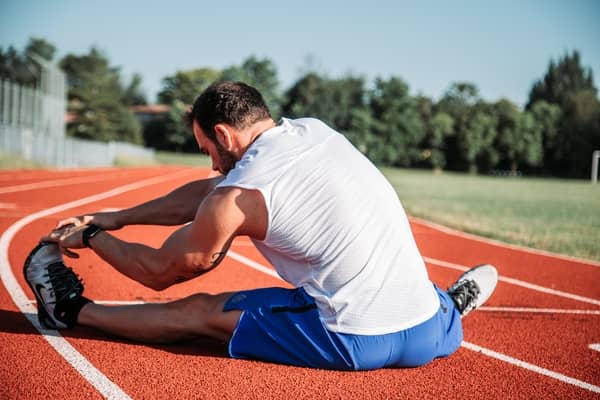
In Traditional Chinese Medicine (TCM), muscle issues are considered related to the liver. Acupuncture may strengthen the body, repair damage to the tendons, and promote an anti-inflammatory response. Many physicians recommended acupuncture or acupressure as a component of prophylactic therapy and standard treatment protocols. By stimulating the acupuncture points for Achilles tendonitis, you can suppress inflammation and bring the body into balance, lightening the burden on the muscles.
In a randomized controlled trial conducted at two separate centers, patients suffering from chronic Achilles tendinopathy reported significantly less pain after acupuncture treatment compared to a control group who engaged in eccentric exercise. Medical case studies have also demonstrated functional improvement and symptomatic reduction in Achilles tendinopathy pain after electroacupuncture treatment, suggesting that stimulation of the relevant acupuncture points may provide effective complementary therapy to traditional treatments.
Although Achilles tendinopathy and Achilles tendonitis have almost identical symptoms, they are different conditions. Tendinopathy refers to the degeneration of the collagen protein that makes up the tendon, while tendonitis simply means inflammation of the tendon. Acupuncture for Achilles tendonitis has also been shown to have a strong therapeutic effect, however. In a 2015 study, 60 patients between 18-55 years old were divided into two groups: an electroacupuncture group and a low-frequency impulse group. Those treated with electro-stimulation at acupuncture points for Achilles tendonitis including BL-57, KD-3, and BL-60 reported a significant decrease in pain, suggesting that electroacupuncture can improve symptoms and heighten the quality of life for patients suffering from inflammation.
If you experience a strong sensation of heat in the inflamed area, it’s important to cool it down using ice or cold water. Where there is no sensation of heat, however, treating Achilles tendonitis with acupuncture is highly recommended.
Will A TENS Unit Help With Achilles Tendonitis?
Transcutaneous Electrical Nerve Stimulation (TENS) uses an electrical current to relieve pain. A TENS machine is a small device that connects to the skin via a series of electrodes. The machine delivers low-frequency electrical impulses to the body, which the patient experiences as a mild tingling sensation. These electrical impulses block the transmission of pain signals to the spinal cord and the brain, which may help to relax the muscles and provide pain relief. TENS treatments may also stimulate the production of natural painkillers in the body, known as endorphins.
During the acute phase of Achilles tendonitis, when redness, swelling, and severe pain are present, TENS is not recommended. At this stage, you should use the RICE method to reduce swelling and cool the affected area. TENS, which stimulates blood flow, may actually worsen the inflammation and cause pain.
In the chronic stage, when the muscles are stiff, TENS may help to increase blood flow to the calf muscles and promote recovery. However, TENS does little to improve muscle flexibility, which means that physical therapy and gentle exercise, such as stretching, remain necessary. When used in combination with acupuncture for Achilles tendonitis and other traditional therapies, TENS may have its place, but it is unlikely to heal inflammation as a stand-alone treatment.
What Are The Acupuncture Points For Achilles Tendonitis?
Acupoint: Bl-58 (Other Names: Bladder-58/Fei Yang/Taking Flight)
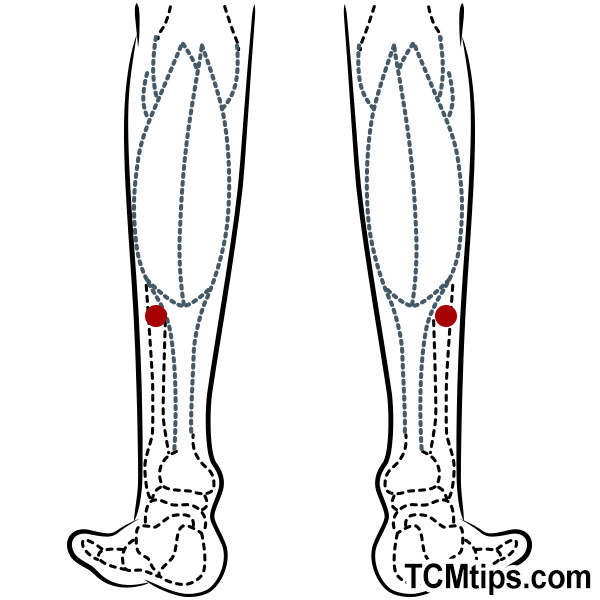 The Fei Yang acupoint is located on the posterior aspect of the lower leg, between the lateral gastrocnemius and the soleus muscles. The gastrocnemius muscle is mainly engaged when walking and running, while the soleus muscle is engaged even when standing and is more likely to get tired. Activating Bl-58 is an easy way to relieve soleus muscle tension.
The Fei Yang acupoint is located on the posterior aspect of the lower leg, between the lateral gastrocnemius and the soleus muscles. The gastrocnemius muscle is mainly engaged when walking and running, while the soleus muscle is engaged even when standing and is more likely to get tired. Activating Bl-58 is an easy way to relieve soleus muscle tension.
Stimulation of the Fei Yang expels wind and dampness from the body and alleviates chronic pain, especially in the lower limbs. This is a powerful acupoint, effective in the treatment of everything from rheumatoid arthritis, hemorrhoids, and cystitis, to dizziness and vertigo. Electroacupuncture at Bl-58 is used to ease tension in the soleus muscle and relieve pain in the lumbar and the sciatic nerve.
Acupoint: KD-9 (Other Names: Kidney-9/Zhu Bin/Guest House)
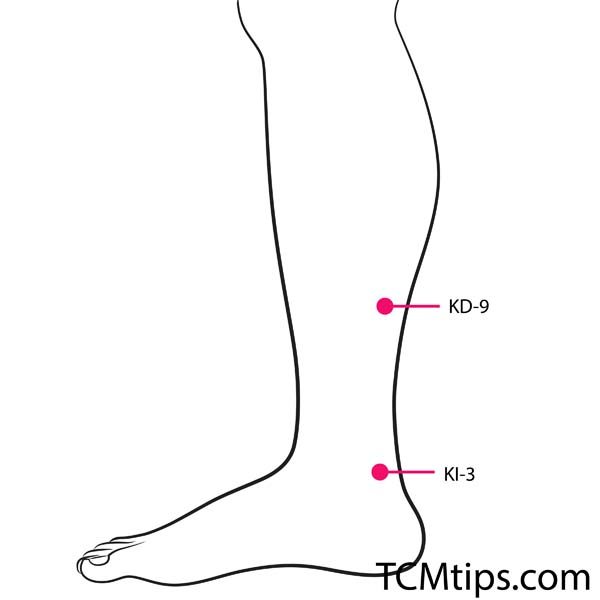
Stimulation of the Zhu Bin increases blood flow and eases pressure on the nerves, relieving pain throughout the body. It’s an excellent acupressure point for lower back pain.
As well as being one of the best acupuncture points for Achilles tendonitis, KD-9 is also one of the primary pressure points for thigh pain. You can massage this acupoint at home, applying firm pressure on both sides.
Acupoint: Bl-57 (Other Names: Urinary Bladder-57/Cheng Shan/Support the Mountain)

Bl-57 is located in the middle of the lower leg. If you extend the toes straight or lift the heel slightly, you can easily locate the point in the depression below the gastrocnemius muscle.
Not only is Bl-57 one of the best acupressure points for heel pain, but it’s also indicated for hemorrhoids and beriberi.
Acupoint: Bl-60 (Other Names: Urinary Bladder-60/Kun Lun/Kunlun Mountains)
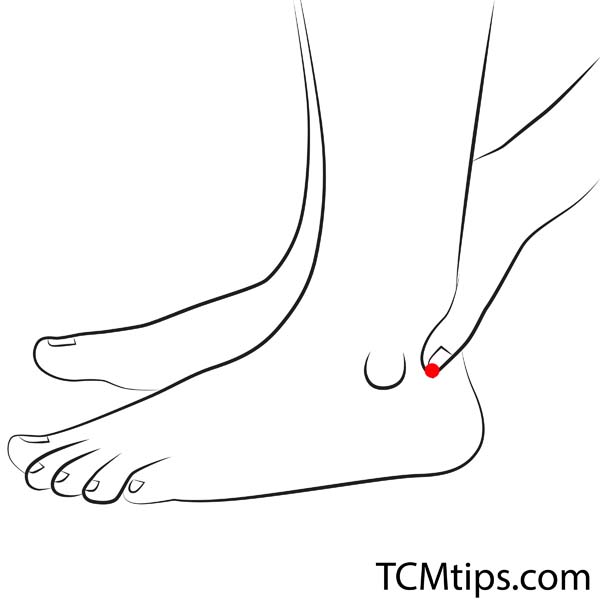
When the Kun Lun acupoint is employed in acupuncture for Achilles tendonitis, the needle is not inserted vertically, but rather horizontally along the tendon. When the tendon is inflamed, it should not be pierced directly. In addition, horizontal insertion widens the range of the stimulus, enhancing the effect.
Stimulation of Bl-60 removes obstructions in the body and relieves inflammation and discomfort in the chest, making it one of the useful acupressure points for fluid around the heart. It can also be used to treat congestion or asthma resulting from imbalances in the heat or cold.
Acupoint: KI-3 (Other Names: Kidney-3/Tai Xi/Supreme Stream)
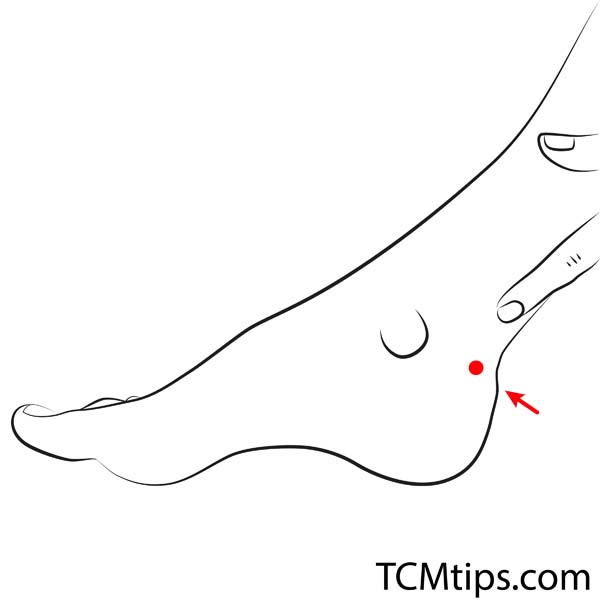 In Traditional Chinese Medicine, the kidney is one of the key energy stores in the body. Stimulating the acupoints along the kidney meridian can give you a much-needed energy boost. Acupressure massage at KI-3 provides a general healing effect, relieves fearfulness and anxiety, and has a general detoxifying effect. KI-3 is also used in acupressure for brain inflammation.
In Traditional Chinese Medicine, the kidney is one of the key energy stores in the body. Stimulating the acupoints along the kidney meridian can give you a much-needed energy boost. Acupressure massage at KI-3 provides a general healing effect, relieves fearfulness and anxiety, and has a general detoxifying effect. KI-3 is also used in acupressure for brain inflammation.
Due to its location on the medial part of the foot, KI-3 is also a good acupoint for alleviating heel and ankle discomfort. You can perform acupressure for Achilles tendonitis on KI-3 at home. Simply find a comfortable position and breathe deeply while applying firm pressure with the thumb.
Acupoint: KD-7 (Other Names: Kidney-7/Fu Liu/Returning Current)

Stimulation of the Fu Liu also helps to lower blood pressure and improve water metabolism, making it useful in acupressure for the heart.

Try our Anti-Aging Gua Sha Tool designed to bring out your skin’s natural glow.
Best Gua Sha Product- Anti-Aging: The tool is designed to target 11 specific aging signs such as wrinkles and sagging skin. By following the 7-step routine, users can improve skin firmness and reduce fine lines naturally.
- Enhances Skincare Routine: It works effectively with serums and lotions, boosting absorption and efficacy of skincare products.
- Visible Skin Improvement: Users can expect a smoother complexion, reduced puffiness, and a more youthful appearance.
 P. Sze
P. Sze 

















